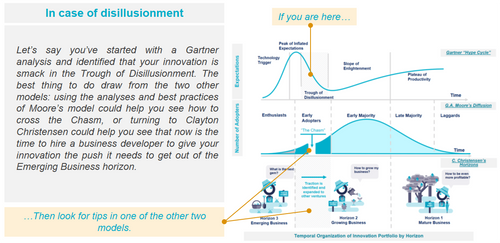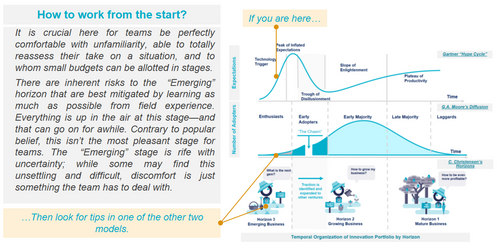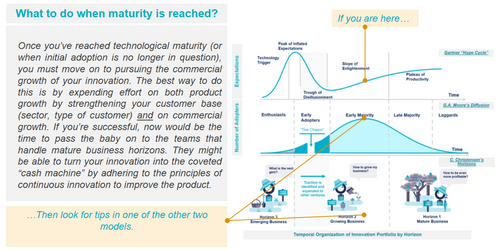Accelerate Innovations by Blending the Best Practices of Three Models of Innovation Diffusion (Gartner, G.A. Moore , C. Christensen)
Introduction
When building innovative products we draw upon several models to help us follow the cycles and gauge products’ maturity levels (technological, market and use). We noticed that 3 complementary, superimposable models converge and together provide a coherence that makes the most of the various recommendations and best practices of each innovation strategy.
The 3 diffusion of innovation models we’ve identified are:
- The Gartner model and “hype cycle”
- Geoffrey A. Moore’s Diffusion of Innovation model
- The “Innovating over the Horizon” model, popularized by Clayton Christensen
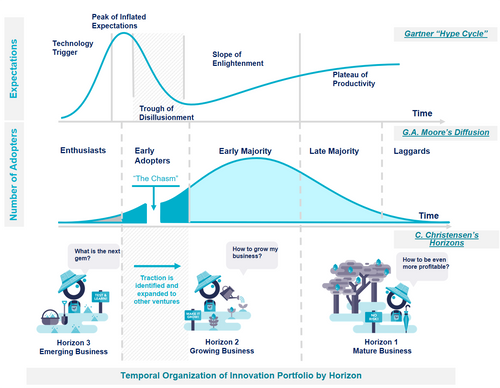
A model remains relevant until refuted by an experiment
When we assist product teams in building their products (innovative or not), we draw upon several models to help us follow the cycles and gauge products’ maturity levels (technological, market, and use).
As we like to say, all models are false but some are useful. I’d add that a model remains relevant and true as long as it hasn’t been refuted by a contradictory experiment.
In other words, a model remains true until an experiment proves it false**.**
From field work, people from organizations to universities have detected several recurring patterns and, through induction, have constructed a series of models. Seldom theoretical and limited in scope, these models are nonetheless quite effective since they are so close to empirical field observations.
[caption id="attachment_76292" align="aligncenter" width="504"] 
Source: https://www.lecolededesign.com/actualites/observation-des-usages-design-thinking-2795[/caption]
The convergence of models confirms their solidity
Among the different models we rely on when providing support or for diffusion of innovation, three are in heavy rotation:
- The Gartner model and “hype cycle”
- Geoffrey A. Moore’s Diffusion of Innovation model
- The “Innovating over the Horizon” model, popularized by Clayton Christensen; https://blog.octo.com/trouver-ou-vous-vous-sentez-le-mieux-pour-innover/
My colleagues and I had many conversations on how different models converge and had drawn a few conclusions on which elements factor heavily in model convergence. When we superimposed the models and supplemented the work with a well-garnished bibliography, our intuitions were proven to be right: the models did in fact converge. And that is a good thing—it means that by combining the 3 models we thought compatible, we were able to reinforce both their solidity and their relevance.
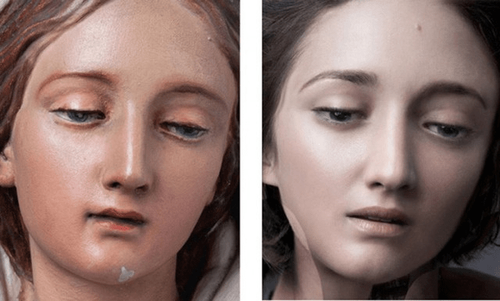
By starting with different perspectives, we were able to clearly see that, once superimposed, the 3 models all converged together to tell the same story. Since pictures speak louder than words, here’s a visual aid to illustrate what happens during the superimposition.

Use the coherence of all three models to benefit from the best practices of each
The coherence of the three models belies their sturdiness and complementarity. From where your innovation is on either model, draw on recommendations and best practices from the other two. A better perspective is the best way to grow your innovation.
Another example: During the Trigger phase, imaginations can run wild when it comes to certain inventions. These “inventions” don’t yet qualify as innovations as they haven’t yet been disseminated in society. Tread carefully here, the terrain can be hazardous**.**
Even once technological and/or adoption maturity is reached that doesn’t mean you’ve won the race. You have to continue developing the product either by extending it to other sectors and client types or by preparing a move to another team in the hopes of creating a cash machine.
Conclusion
As we said, the coherence of the 3 models shows their strength and complementarity (in terms of analysis perspective and, especially, in terms of innovation management and diffusion). In other words, you can rely on all 3 models at once to manage your innovation portfolio and draw on the best practices of all three**.**
One caveat, however: The placement of your innovation is only dependent on expert opinion—yours, your team’s, or an external expert’s. It’s pretty safe to assume no scientific formula was used to ascertain the placement of your innovation on a set of regimented graphs or within a given horizon. You’re going to have to figure that out on your own. The best way to correctly position your innovation is to count on your own analysis and on the knowledge you’ve shared with the team managing the innovation.
[caption id="attachment_76313" align="aligncenter" width="340"]
Src : https://www.mdcu-comics.fr/news-0023965-divers-lego-nous-presente-ses-brickheadz-dc-et-marvel.html & crédit : Warner Bros[/caption]
This might all seem theoretical to you at this stage but by reading the literature associated with each model (something we do regularly), you’ll find a wealth of best practices to apply to your work. Something a blog post, sadly, is much too short to accomplish! And keep in mind these models are empirical, from the field. The literature is teeming with concrete, applicable, and inspiring best practices.
Lastly, these models should be used to help you arbitrate, project, or decide on how much time and money is worth investing in the project and are not an end on and of themselves.
Going Further – OCTO & USI
USI Talks – Unexpected Sources of Inspiration
- Innovation et sortie de crise - Marc Giget**, USI 2013** (in French)
- The Myths of Innovation - Scott Berkun, USI 2014
- Créer une proposition de valeur attrayante dans un business model innovant - Yves Pigneur**, USI 2015** (in French)
- De quoi l'innovation fut-elle le nom ? - Vincent Bontems**, USI 2016** (in French)
- 3 Keys to Innovation within the Enterprise - Ash Maurya, USI 2017
Extremely Inspiring Literature
- The Innovator’s Dilemma, Clayton Christensen
- Crossing the Chasm, Geoffrey A. Moore
- Running Lean, Ash Maurya
- Scaling Lean, Ash Maury
